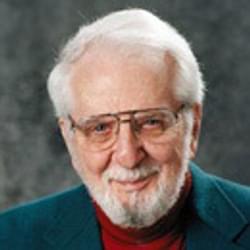




Tom was instrumental in founding the non-profit Iowa Trails Council in 1984. He made the first application for acquisition of an abandoned rail bed in Iowa and continued to negotiate, acquire, and establish trails for many years.

Iowa lost one of its trail pioneers last week.Thomas Neenan Sr., 92,
passed away Tuesday, September 8, after a short battle with bone cancer.
Tom’s lifetime boasted a wealth of achievements, but it’s his
dedication and passion for Iowa’s trail systems that will be most
remembered.
Read more about Tom's passion for trails in this 1997 article written by Tom.
Iowa: Out front on rail trails and bike trails
Few Iowans seem to be aware that their state is though of across the nation as being more than the nation's food capital. Iowa is also considered by many to be the out-front state when it comes to trails. For many years, Iowa led the nation in the number of miles of railroad rights of way converted to trails. There were thousands of miles of railroad corridors crisscrossing Iowa, and many of these were abandoned following the building of interstate and intrastate super highways.
Iowa has a unique system of county conservation boards that have become dedicated to preserving rare pieces of land and creating recreational facilities. The acquisition of former railroad corridors fit ideally into both categories.
Also, in 1984, the Iowa Trails Council was formed. This organization has its single purpose for the acquisition, development and promotion of trails. A major force in the creation of the council was the passage in 1983 of an amendment to the National Trail System Act. This encouraged the preservation of railroad rights of way for possible reactivation of service when this again became practical, keeping the corridor open by creating interim use of the right of way as a trail.
The council was quite aggressive in its desire to preserve these rights of way as they were being abandoned and the founders of the council were eager to take advantage of the 1983 federal legislation. The law was challenged in the courts by some who believed the law to be an infringement on their property rights. It continued on appeals until reaching the U.S. Supreme Court, where in 1990 the law was unanimously declared by the court to be constitutional.
From 1983 until the court's ruling in 1990 there were only 13 certificates issued by the federal government for creation of rail trial under terms that legislation. Eleven of those 13 were in Iowa, testimony to the perseverance of the trails council and the county conservation boards that participated.
Prior to that period, Iowa was quite typical in that most of its trails were more like paths in the state and county parks. Today people frequently refer to the rail trails in Iowa as bicycle trails because bicyclists are prevalent users. Some of the longer rail trails in Iowa, such as the popular Raccoon River Valley Trail between Waukee and Yale in Dallas and Guthrie counties, have been paved to satisfy this segment of trail advocates. Northern portions of the first long (53 miles) rail trail in Iowa, and one of the early conversions in the nation, the Cedar Valley Nature Trail between Waterloo and Cedar Rapids, are now also paved.
It was this trail that caused people in the middle and late 1970's inside and outside Iowa to take sides as to whether its construction was a good idea. As a result, members of the ITC have traveled to Indiana, Missouri, Nebraska, and Kansas to assist in establishing rail trails in those states. Requests for speaking engagements in other states continue today.
The problems envisioned with the Cedar Valley Nature Trial did not occur, and users of the trail are family-oriented nature lovers. It is common to see families of bicyclists, some pulling carts with young children, on any of these trials. Rail trials are quite level, easy to traverse and filled with opportunities to observe natural settings that have been preserved, in many instances, for a century or more. Some of the rarest of prairie stands are to be found along these corridors.
Several have been incorporated into the national American discovery Trail that passes through Iowa en route from California to Delaware. Many of these trails attract out-of-state visitors, making the trails economic assets to our state.
Memorial: Donn Steven Anderson
posted Jul 13, 2023
Steve’s lifework and legacy ended up creating terrific trails for hikers, mountain bikers and equestrians.
posted Feb 11, 2022
Former American Trails Board Member Kay Lloyd passed away in January 2022.
September 11th National Memorial Trail to Offer Interactive Map
posted Sep 11, 2021
The September 11th National Memorial Trail is a 1,300-mile system of trails and roadways that link the National September 11 Memorial and Museum in New York City, the National 9/11 Pentagon Memorial in Arlington, Virginia, and the Flight 93 National Memorial in Shanksville, Pennsylvania.
posted Dec 4, 2020
Longtime American Trails board member Joe Taylor passed away 12/03/2020.
1,181 views • posted 09/08/2015